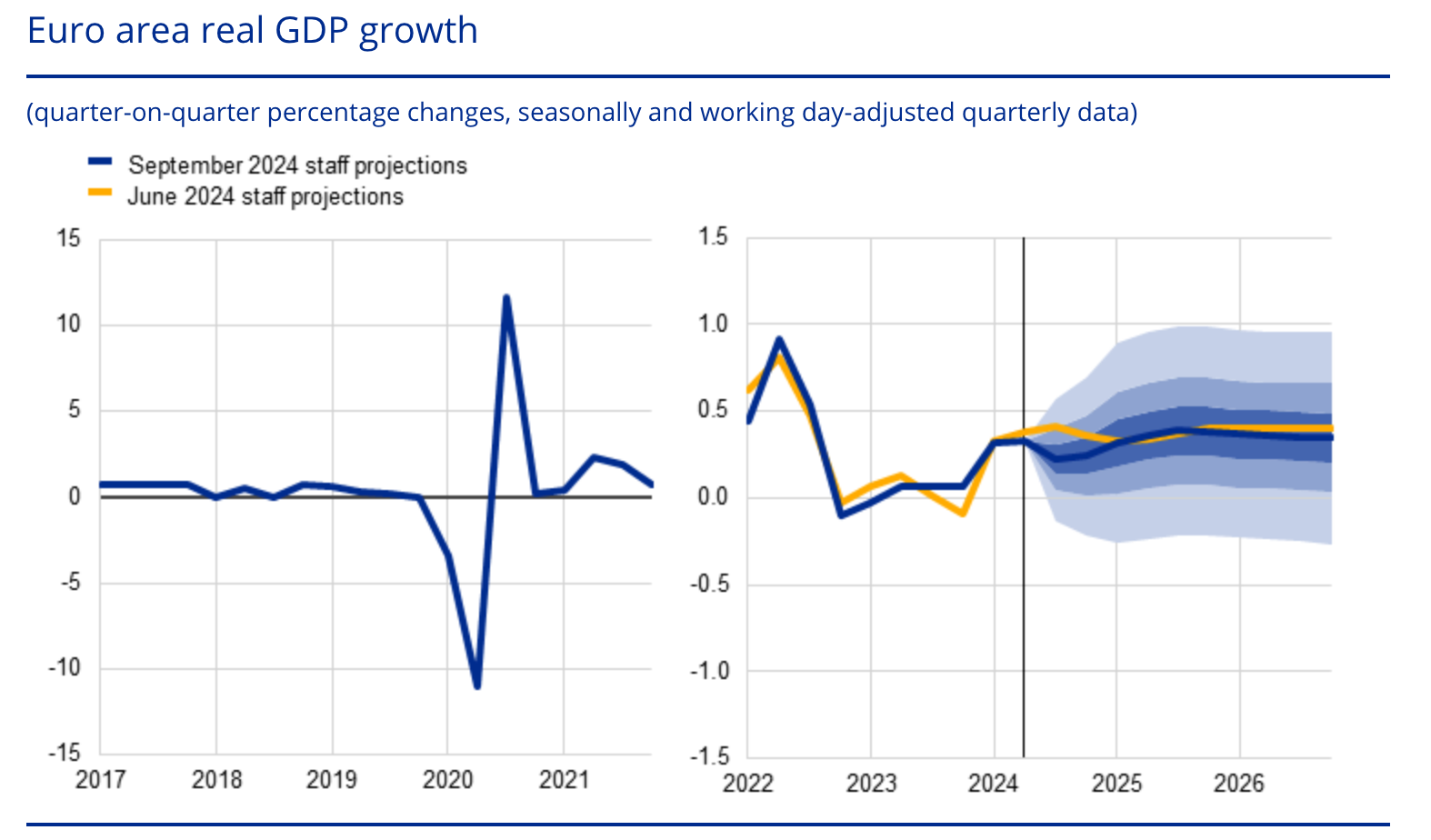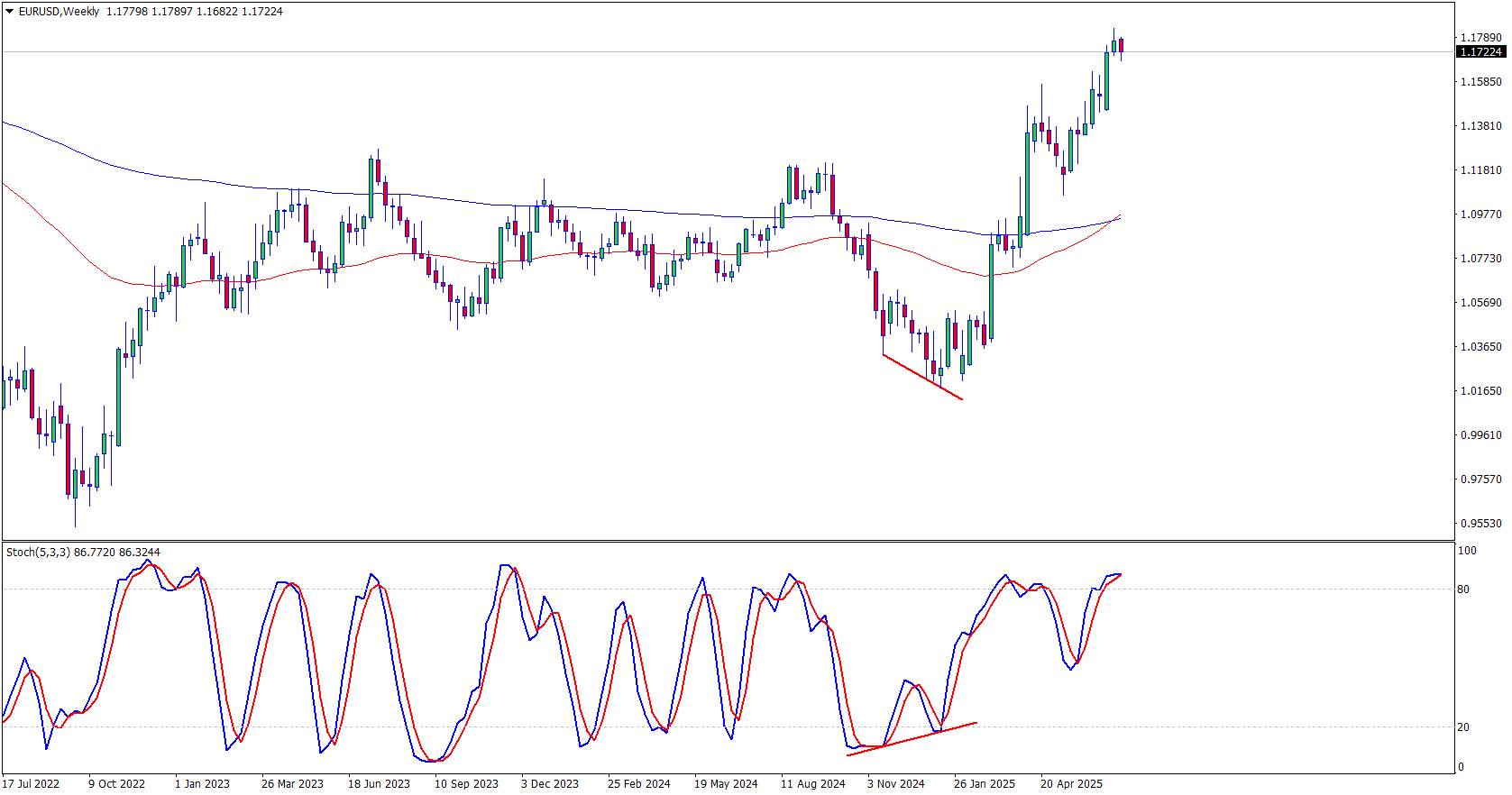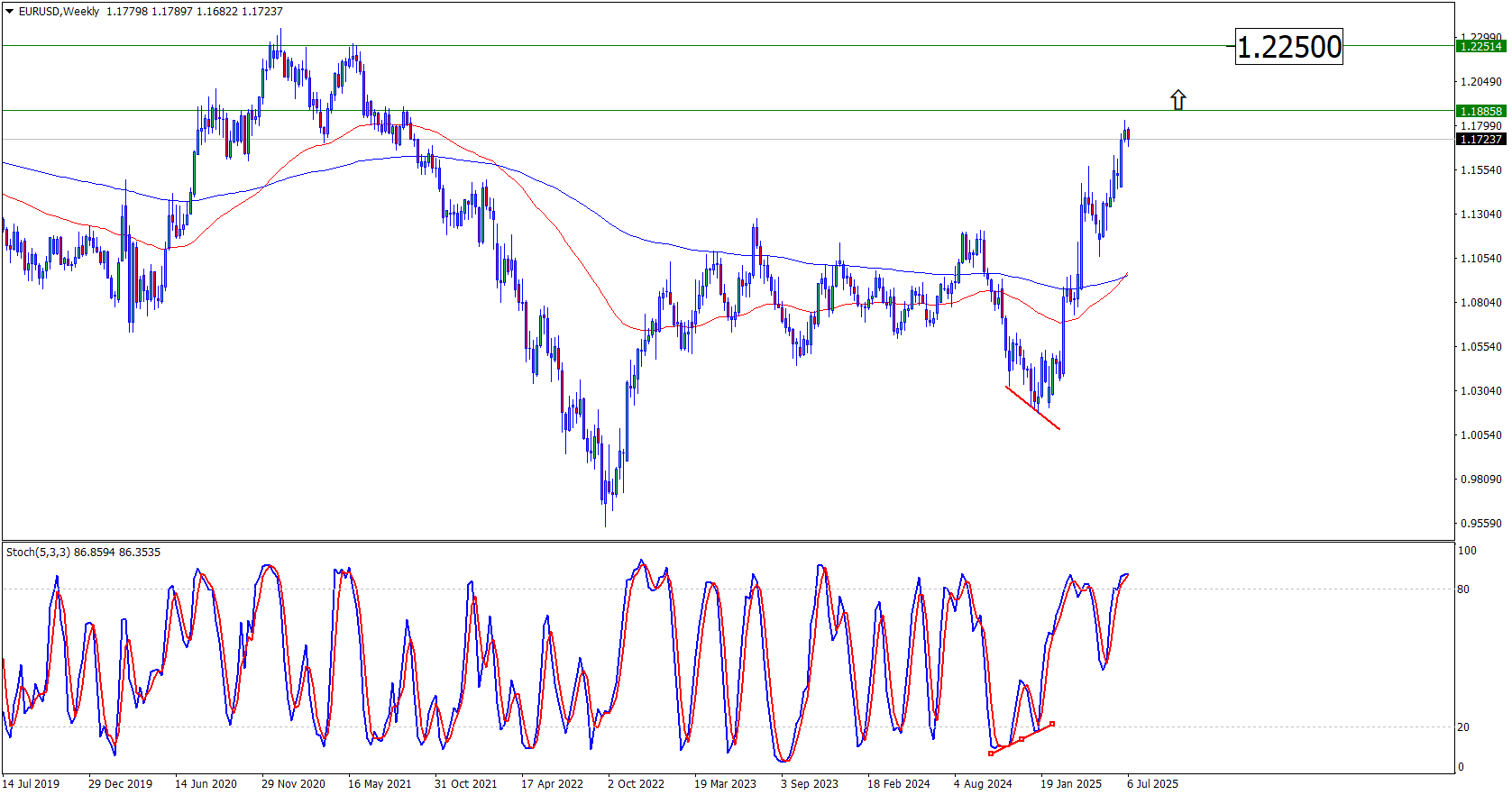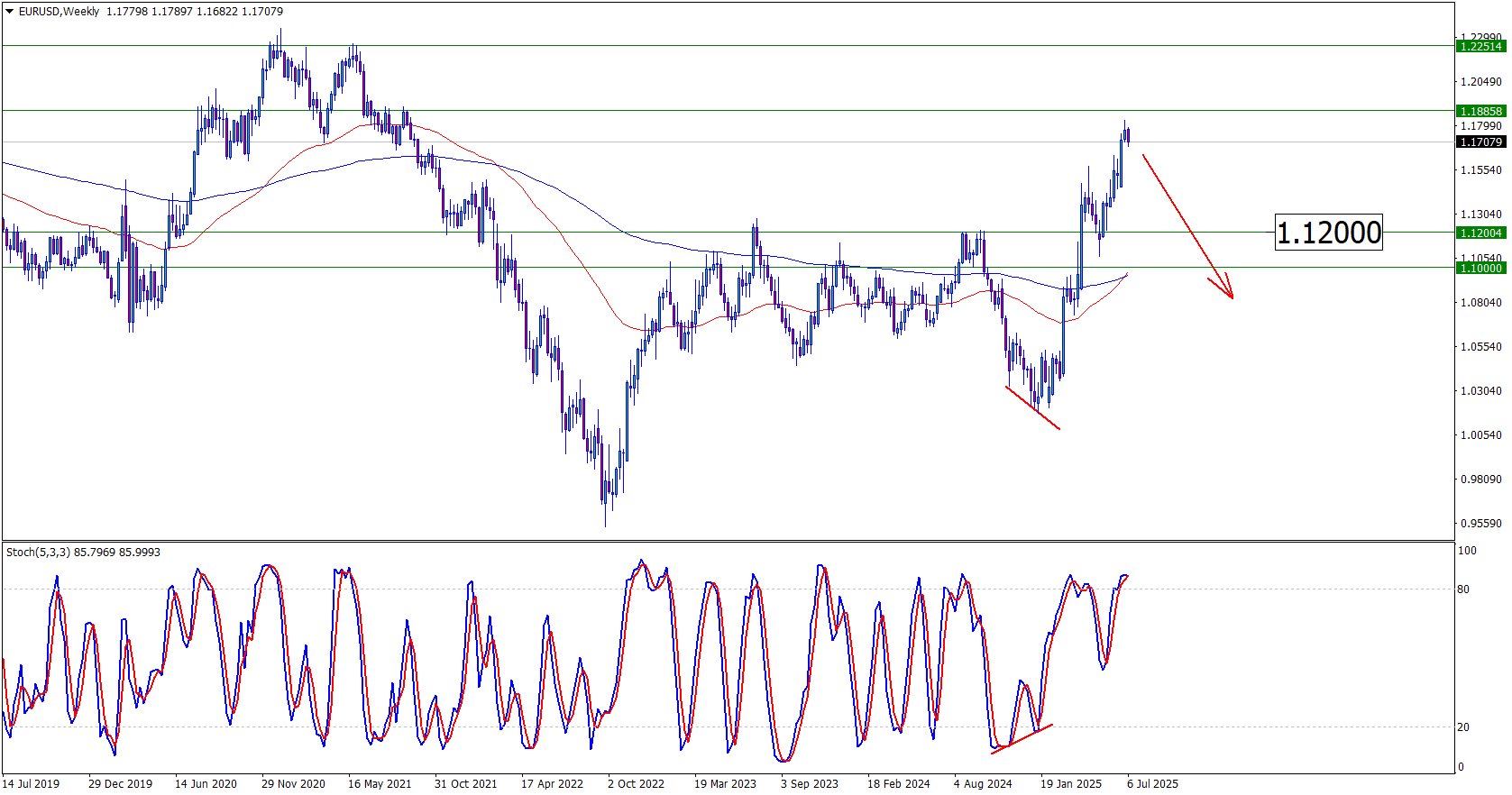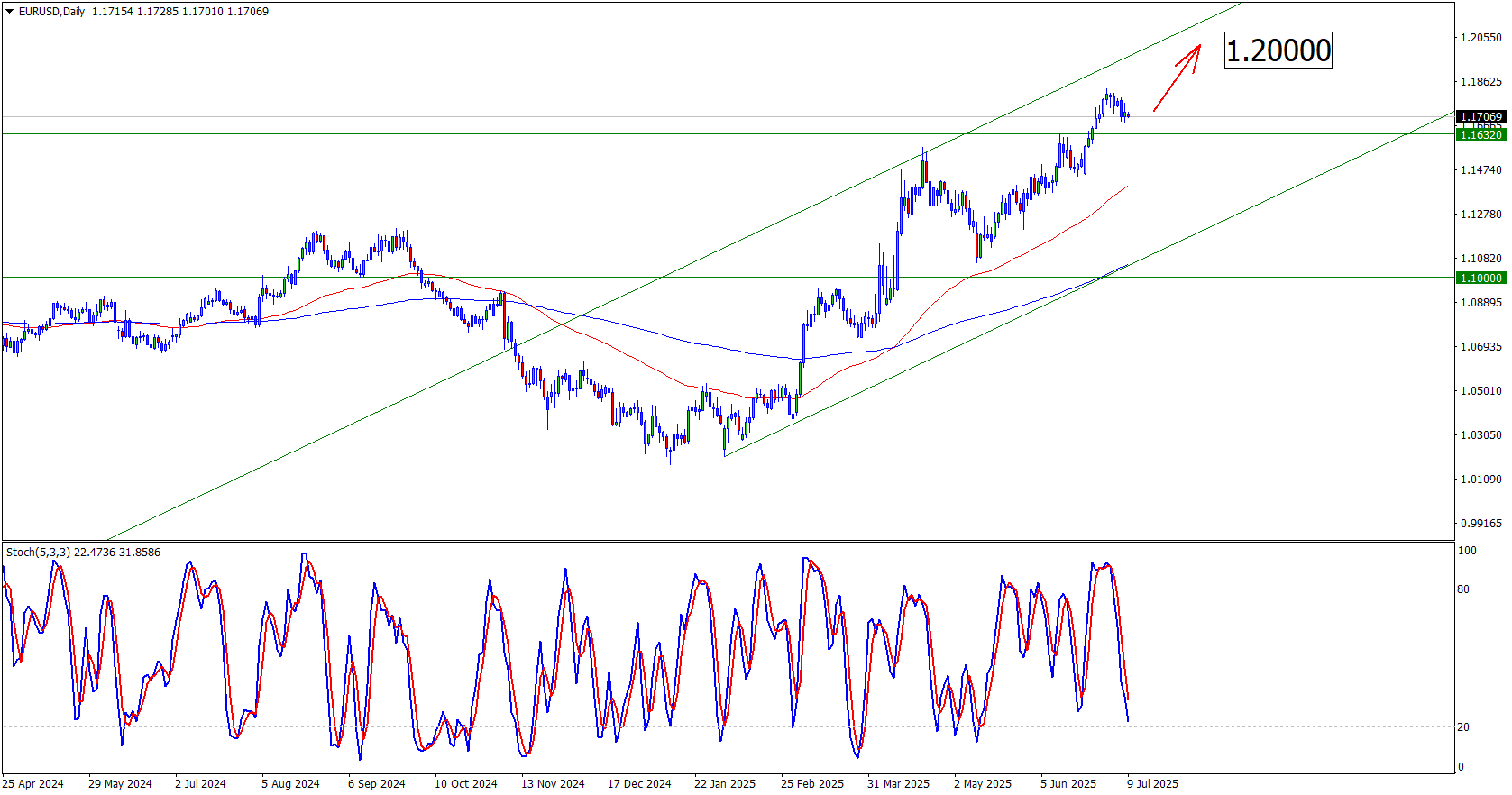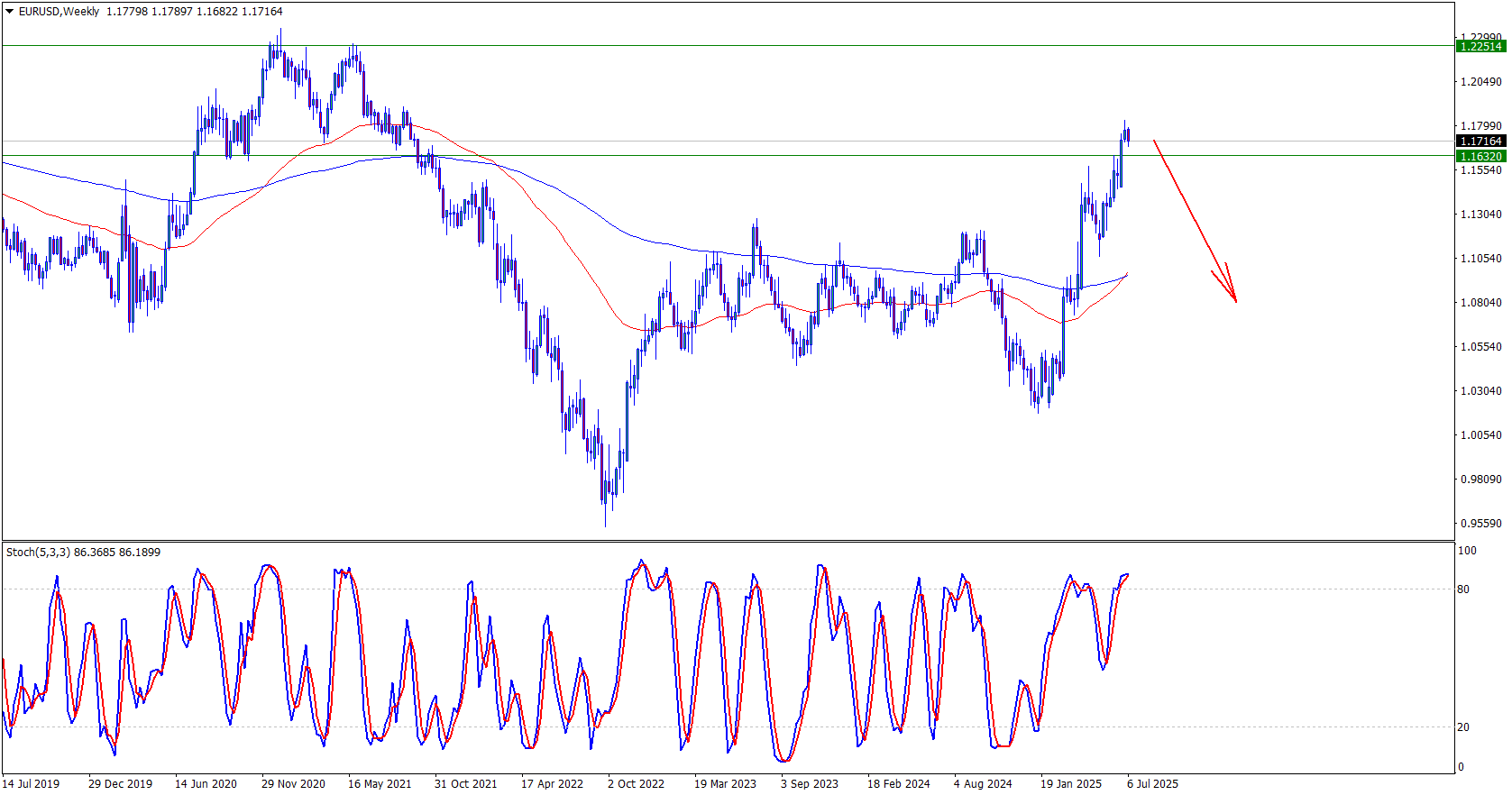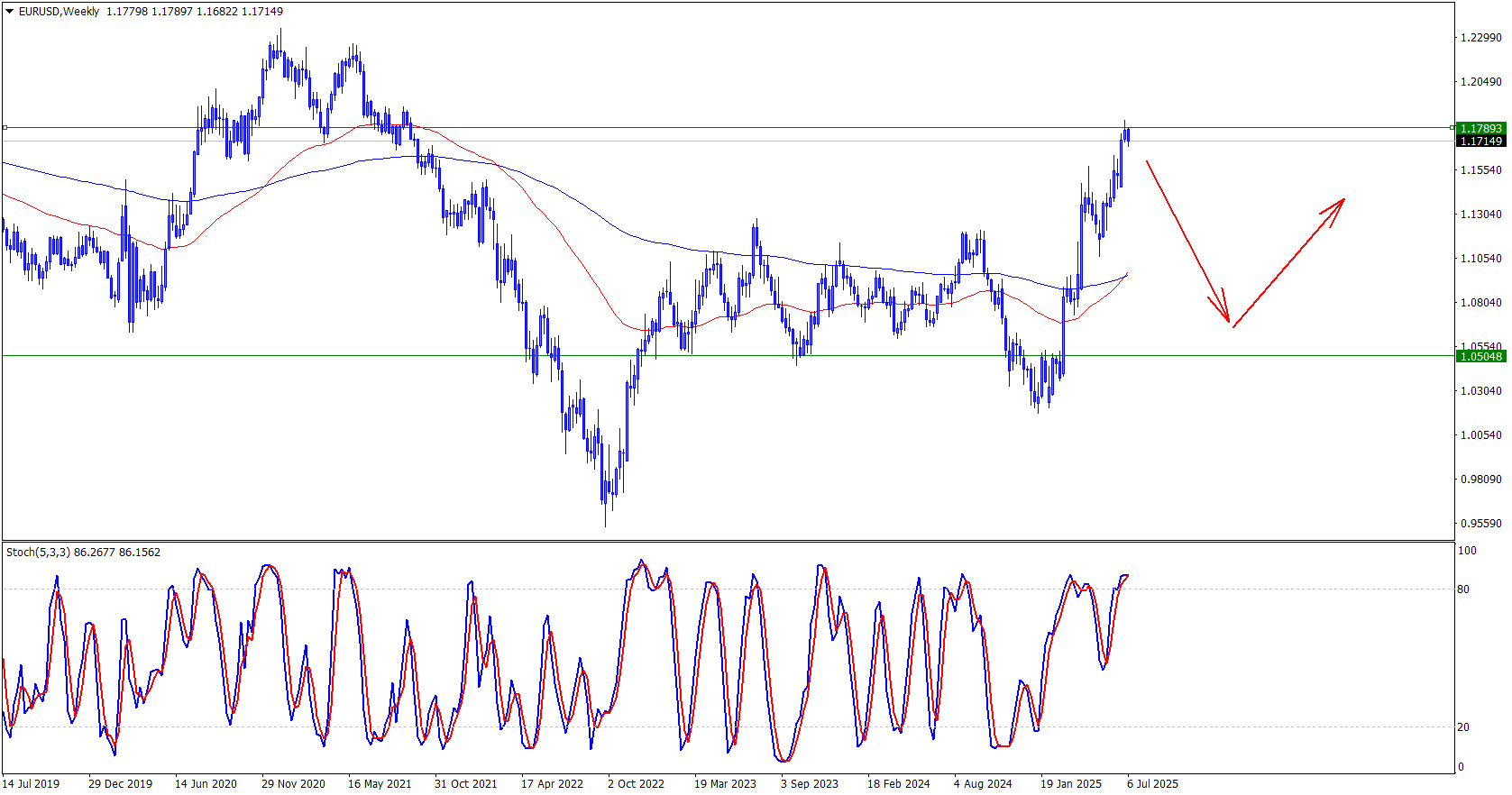EURUSD 2025-2027 forecast: key market trends and future predictions from AI and major banks
Disclaimer: the information in this article is based on the analysis of reputable financial resources and analytical data from RoboForex specialists. It reflects the conclusions of thorough research, but it should be taken into account that economic changes may significantly affect market conditions, which may lead to changes in forecasts. We recommend conducting your own research and consulting with professionals before making important financial decisions.
The EURUSD pair started 2025 under bearish pressure after a significant decline in the second half of 2024. However, in the first half of 2025 the euro has rebounded strongly, recovering a large portion of those losses amid shifting expectations around central bank policies and economic data. Geopolitical events and macroeconomic indicators continue to influence the pair’s dynamics. What is the outlook for EURUSD in the coming years given the evolving market conditions?
This article provides the EURUSD forecast for 2025, 2026 and 2027 and highlights the main factors determining the direction of the pair’s movements. We will apply technical analysis, take into account the opinions of leading experts, large banks, and financial institutions, and study AI-based forecasts. This comprehensive insight into potential EURUSD movements should help investors and traders make informed decisions.
Table of contents:
- EURUSD forecast key points
- Factors affecting the EURUSD forecasts
- What happens with EURUSD in 2025?
- EURUSD live price chart
- Technical analysis of EURUSD for 2025
- Long-term technical analysis of EURUSD for 2025
- Expert EURUSD forecasts for 2025
- EURUSD predictions for 2025 from AI
- Long-term EURUSD expert forecasts for 2026
- Long-term EURUSD predictions from AI for 2026-2027
- EURUSD forecast: risks and considerations
- Conclusion
- FAQ
EURUSD forecast key points
Before we get into a detailed analysis and forecast for EURUSD for 2025, 2026 and 2027, let's take a look at the crucial factors that have the biggest impact on this currency pair.
- Eurozone economic outlook. The euro area’s economic growth remains modest. GDP forecasts stand around 0.9% for 2025 and 1.4% for 2026, indicating only a gradual recovery. The 2025 projection has been revised slightly downward from earlier estimates due to weaker-than-expected performance in late 2024 and lingering uncertainty. Nevertheless, a moderate rebound is expected by 2026 as inflation pressures ease and investment picks up.
- Fed's interest rate policy. The difference in interest rates remains a key factor. A sharper rate cut by the ECB compared to the Fed could support the strengthening of the US dollar. The Fed is likely to take a cautious stance, reducing the rate only twice in 2025 (instead of four times as initially forecast).
- Eurozone and US inflation. Eurozone inflation is forecast to drop from 2.4% in 2024 to 1.9% in 2025-2026, potentially influencing EURUSD. In the US, inflation rose to 3.3% in January, leading the Fed to maintain rates at 4.25%-4.50% in early 2025.
- Geopolitical risks. Middle East instability has raised energy prices, with potential disruptions to supply chains and EURUSD.
- EURUSD expert and AI forecasts. Professional forecasts for EURUSD are mixed. Some analysts see the euro continuing to strengthen if European growth stabilizes and the Fed pivots (with predictions of EURUSD potentially reaching the mid-1.10s or higher), while others foresee a renewed dollar rally pushing the pair lower (some worst-case scenarios even point to parity or below). The range of projections for the EURUSD rate by end-2025 is wide – roughly from 0.9000 up to 1.1800 – reflecting high uncertainty. For instance, certain AI-driven models anticipated levels as low as ~0.90, whereas more optimistic forecasts from other sources see the euro testing 1.12–1.18 or beyond if conditions favor it.
As part of the EURUSD forecast for the remainder of 2025, it is expected that the currency pair’s dynamics will be shaped by a combination of monetary policy shifts by the Fed and ECB, as well as evolving inflation and geopolitical factors. Forecasts for the pair remain varied: a bullish scenario envisions an extension of the current uptrend toward 1.16 and potentially 1.18–1.19 if economic conditions in the Eurozone continue to improve and the Fed leans dovish. A bearish scenario would unfold if the euro’s support levels (like 1.12–1.10) give way – in that case, a fall back toward 1.05 or even parity 1.00 could occur under a resurgent US dollar. A sideways scenario is also possible, wherein EURUSD consolidates between roughly 1.10 and 1.18 if neither bulls nor bears gain a decisive upper hand.
Factors affecting the EUR USD forecasts
Understanding the key factors affecting the EURUSD rate is crucial for accurate exchange rate forecasts. Below are the main factors that will determine the currency pair’s direction in the coming years.
- Central bank policies. The European Central Bank and the Federal Reserve have a key impact on the EURUSD behaviour. Decisions on interest rates and inflation targets may dramatically change market sentiment, leading to large-scale sell-offs. A more aggressive Federal Reserve policy may help strengthen the US dollar.
- Economic growth and GDP data. Economic indicators from both the Eurozone and the US play a key role in shaping the EURUSD exchange rate. Strong GDP growth in the Eurozone could support the euro, while a slowdown in the US economy might weaken the US dollar. The difference in economic growth rates between the regions will define the long-term prospects for EURUSD, influencing overall market trends.
- Inflation rates. Inflation significantly impacts central banks’ decisions and hence the national currency rate. If the eurozone inflation outstrips the US, it may force the ECB to delay interest rate cuts, prompting investors to invest in the US dollar.
- Political and geopolitical events. Political stability in the eurozone and the US considerably affects the EURUSD movements. For instance, the US presidential election may greatly influence the currency pair’s moves, changing market expectations and investor sentiment. Energy crises and regional conflicts also add to market volatility, prompting investors to seek safer assets like the US dollar.
- Trade balances and current account deficits. The trade balance between the eurozone and the US plays a significant role in the EURUSD dynamics. An increase in the US trade balance deficit could weaken the US dollar, while the increased trade surplus in the eurozone might support the euro.
- Market sentiment and risk appetite. The EURUSD pair also responds to global market sentiment. Conflicts and wars may significantly affect economic growth and inflation in the US and the eurozone.
Evaluating and understanding these factors is crucial for analysing future currency fluctuations and creating EURUSD forecasts. The assessment of the pair's movements and events in 2024 shows that these drivers will determine the trend not only this year but for several years ahead.
What happens with EUR USD in 2025?
In 2025, the EURUSD currency pair has seen a notable shift in its trend. A long-term downtrend that started in September 2024 persisted into early 2025, but by the second quarter of 2025 the pair has broken out to the upside. The euro’s rebound has been fueled by changing expectations of central bank policy and relative economic performance. Currently, EURUSD is trading around 1.15, having decisively surpassed the crucial resistance levels that capped it in late 2024. This break above the 1.10–1.12 zone has opened the way for further growth toward the mid-1.10s and possibly higher.
If bullish momentum continues and the pair sustains above former resistance (now turned support) around 1.12, buyers could drive the quotes up to the next targets in the 1.16–1.18 range. However, if EURUSD falters and slips back below 1.12, it would signal a loss of upward momentum; renewed seller pressure could then drag the quotes down toward 1.10 or lower, with a potential retest of the 1.05–1.03 area. Let’s consider the fundamental factors that can stimulate traders to buy or sell EURUSD in 2025:
Economic growth rates in the Eurozone and the US
Growth stayed tepid entering 2025, yet the euro area surprised on the upside. Eurozone GDP rose 0 .3 % QoQ in Q4 2024, then 0 .6 % QoQ in Q1 2025—its best pace since 2022—lifting YoY growth to 1 .5 %. Even so, full-year 2025 is still seen near 0 .9 %, capped by high rates and weak external demand, before edging up to 1 .4 % in 2026.
Source: https://www.ecb.europa.eu/
The US stumbled: Q1 2025 GDP dipped -0 .1 % QoQ after a strong Q4, hit by tariff-driven import spikes and lower federal spending. Core domestic demand stayed firm (+2.5 % in final sales), and most analysts expect growth to rebound later in 2025, leaving the year around 1 .9 % (vs. 2.8 % in 2024) and stabilising near 2 % in 2026. A relatively stronger Eurozone start has lent EURUSD support, but advantage may shift if US momentum recovers.
Comparing the ECB and Federal Reserve monetary policies
ECB: After rapid hikes in 2022-23 the Bank cut rates by 25 bp in Dec 2024, then paused to gauge inflation’s slide toward 2 %. More cuts are pencilled in for late-2025, but pace remains data-dependent.
Fed: Having lifted its target to 5.00-5.25 %, the Fed has held steady through H1 2025, citing sticky core inflation. Markets now price only one or two small cuts late in the year.
Policy divergence has narrowed: the ECB is already easing gently, while the Fed has stopped tightening. If the Fed pivots sooner or faster than the ECB, the dollar’s yield edge fades—bullish for the euro.
Inflation rate
Eurozone HICP averaged 2.4 % in 2024 and is projected near 2.1 % in 2025 and 1.7 % in 2026 thanks to cheaper energy and easing bottlenecks. Should prices re-accelerate (energy shock, wage spiral), the ECB could slow or reverse cuts, capping EUR strength.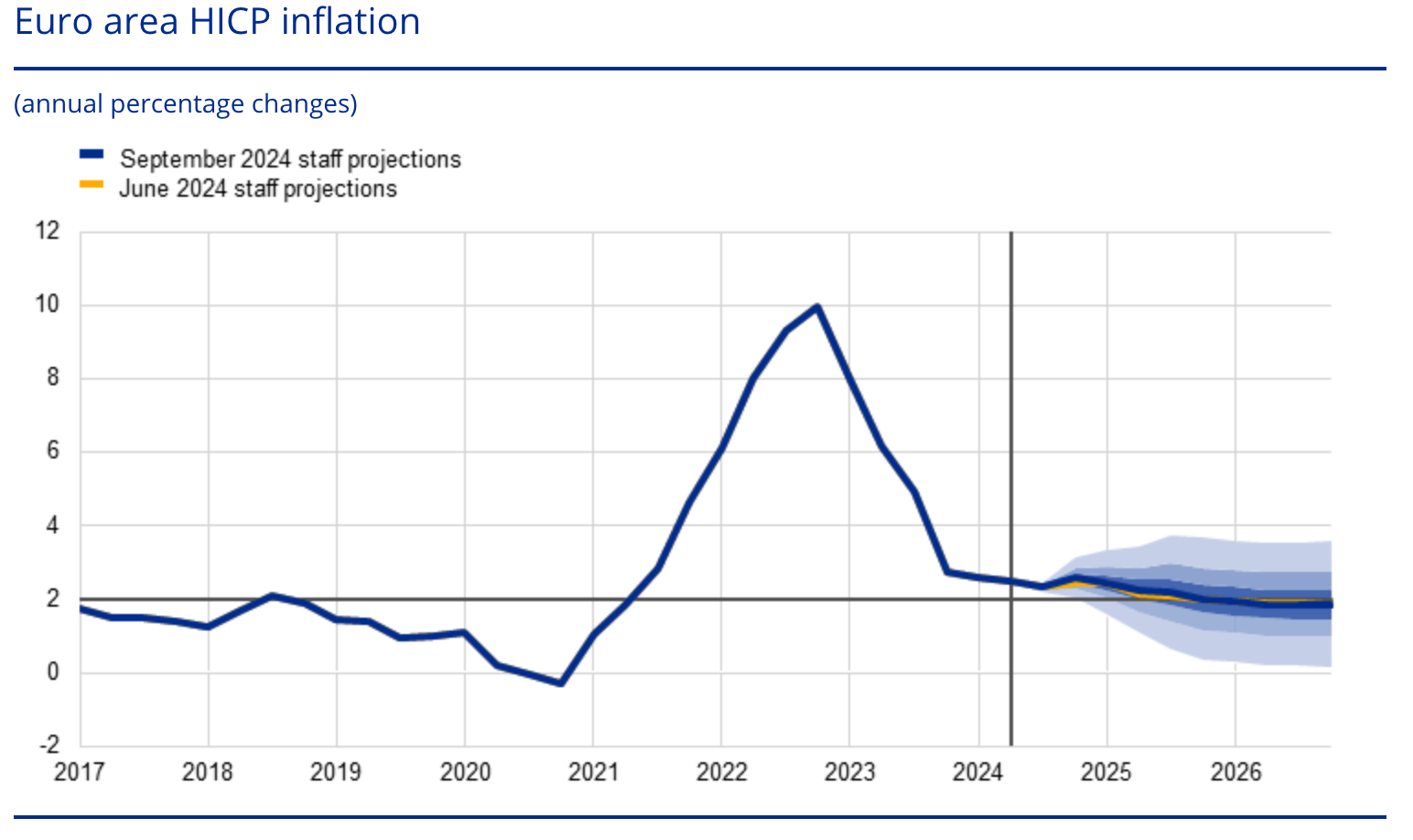

Source: https://www.ecb.europa.eu/
US CPI ran in the mid-3 % range late-2024 and was 3.3 % YoY in early-2025; core PCE is likewise sticky. Fed officials insist inflation must convincingly head to 2 % before meaningful easing. Forecasts see CPI near 2.5 % by late-2025 and 2 % in 2026, barring new shocks. A slower-than-expected decline would keep US rates—and the dollar—higher for longer.
Trade balances and current account deficit
The US’s chronic trade gap widened to $78 bn in Nov 2024 and swelled further in Q1 2025 on pre-tariff import surges, underscoring reliance on capital inflows and posing long-run USD risk if funding appetite fades.
The Eurozone still shows a surplus (~€16 bn in Nov 2024) but it has narrowed as energy costs rise and Chinese demand softens; in spring 2025 the current-account balance briefly plunged. Sustained deficits in Europe would erode a traditional euro support, while an even larger US gap could weigh on the dollar.
Impact of geopolitical risks
Ukraine: Any escalation strains European sentiment and energy supply; de-escalation boosts the euro.
Middle East: Fresh unrest could lift oil prices, hurting energy-import-dependent Europe more than the US.
US-China trade war: Steep 2025 tariffs fuel global risk-off flows favouring USD, yet trade diversion might help EU exporters.
Overall, 2025’s geopolitical flashpoints inject volatility; prudent risk management is essential as sudden swings can override fundamentals.
EUR/USD live price chart
Technical analysis of EURUSD for 2025
On the daily timeframe, the technical picture for the EURUSD pair has significantly improved compared to the end of 2024. The downtrend that dominated the second half of 2024 has been replaced by an upward trend. Notably, the price has risen above its 65-day exponential moving average (EMA-65) and even the longer-term 200-day exponential moving average (EMA-200), signalling a shift towards bullish market sentiment.
Momentum indicators support the bullish scenario. For example, the stochastic oscillator showed a classic bullish divergence at the beginning of the year – while the price reached lower lows, the stochastic lows were higher, indicating weakening bearish momentum. Subsequently, the %K and %D lines turned upwards from oversold levels, reinforcing the likelihood of a bullish reversal. As the rally continued, the daily stochastic occasionally entered the overbought zone, which is expected in a strong uptrend. Currently, the oscillator remains elevated, indicating strong upward momentum.
After a rapid rise, the EURUSD pair tested the 1.1400–1.1450 area and formed a corrective wave. Following a four-week correction, buyers accumulated sufficient positions, and the quotes made another surge, testing the 1.1800 level. At this stage, the EURUSD price is preparing to form another corrective wave.
Short-term outlook: The technical outlook for the near term suggests a mixed but overall bullish bias. According to the current technical picture of the EURUSD pair, the most likely scenario is a minor pullback or price consolidation around the 1.1700 level, after which the quotes may form another upward impulse. A breakout above the resistance level at 1.1880 would signal the continuation of the uptrend with the prospect of testing the 1.2250 mark.
The bearish scenario on the daily chart will be confirmed if the current rise of the EURUSD pair fails and the pair falls back into its previous range. An early warning of this would be a drop below 1.1200, and especially a fall below the support zone at 1.1000–1.1050. In the bearish case, we could see the pair decline to 1.0800 or 1.0550.
If sellers decisively push the price below 1.0550, this would indicate a revival of the broader downtrend, exposing targets such as 1.0200 and ultimately the parity zone at 1.0000.
Technical indicators such as the stochastic are likely to shift from overbought to neutral if this scenario begins to unfold. The price reaching the EMA-200 would be an additional signal of a trend reversal.
There is also a possibility of a sideways consolidation if neither bullish nor bearish breakouts occur in the coming months. In such a case, EURUSD could oscillate roughly between 1.12 on the lower end and 1.16 on the upper end, forming a horizontal trading range. This could happen if the market awaits clearer fundamental cues (like concrete signals from the Fed or ECB). For instance, if buyers cannot push past 1.16 but sellers also fail to break below 1.10–1.12, the pair might enter a consolidation phase. In this scenario, we would see range-bound trading where short-term traders buy near support and sell near resistance, until a catalyst leads to a breakout. Prolonged sideways movement would indicate a market in equilibrium, reflecting indecision about the next trend direction.
To sum up the daily technical analysis for 2025: key levels to watch are approximately 1.12 (support), 1.10 (major support), 1.16 (initial resistance), and 1.18 (next resistance). A confident breakout above resistance around 1.16–1.18 would reinforce the bullish momentum with potential for growth toward 1.19–1.20. Conversely, a breakdown below support at 1.10–1.12 could signal a bearish shift, targeting 1.05 and lower. If neither breakout happens immediately, EURUSD may spend some time consolidating its gains in a range, digesting the year’s earlier move before the next big trend emerges.
Long-term EURUSD technical analysis for 2025
To prepare a longer-term EURUSD forecast, we will examine the weekly chart of the pair. By analyzing the broader timeframe, we can identify major trends and critical levels that might not be as evident on the daily chart. We will apply technical analysis tools, highlight three possible scenarios (bullish, bearish, and sideways), and mark crucial levels on the EURUSD weekly chart. This will help assess the pair’s potential movements in the long term (through the end of 2025 and into 2026).
Potential long-term scenarios for 2025
Bullish scenario: On the weekly chart, EURUSD continues its upward trend, having tested the 1.18 level and demonstrating another update of its 2025 highs. Although the 2021 highs are still far away, after a correction and with positive data from the Eurozone, it is possible that the pair may continue to rise.
The weekly stochastic oscillator is in the overbought zone (~80), which signals the formation of bearish sentiment.
In our bullish scenario, EURUSD continues to rise in the second half of 2025. Some resistance may emerge around 1.1880–1.2000, near the upper boundary of the long-term ascending channel. If the pair manages to consolidate above this channel resistance (around 1.20), it would strongly confirm the continuation of the uptrend.
The next targets within this bullish scenario would be the 1.2000 level, followed by 1.2250–1.2300 (levels last seen at the beginning of 2021). However, it is important to note that reaching these higher targets may be delayed until 2026, depending on the pace of movement. In the shorter term, a more realistic bullish target by the end of 2025 could be the 1.20–1.21 range.
The bullish scenario would be invalidated if EURUSD unexpectedly reverses and breaks back down below an important support level such as 1.1200 on a weekly close. In particular, if the price falls and consolidates below 1.1000, it would cancel the forming higher-low structure and return control to sellers.
Overall, the long-term bullish forecast suggests a gradual strengthening of EURUSD with a possible reach to the mid-1.20 range or higher by the end of 2025, provided that fundamental factors (e.g. Fed policy easing and Eurozone stability) align with the technical breakout.
Bearish scenario: Despite the recent rally, it is possible that the broader downtrend is not yet over and the euro’s strengthening is only a temporary phenomenon. Within the framework of the long-term bearish scenario, the current rise in EURUSD is viewed as a corrective rally within the multi-year bullish trend of the dollar.
On the weekly chart, EURUSD has broken out above its annual sideways range (approximately 1.05–1.12); the bearish view interprets this move as a potential false breakout if the price fails to hold at the reached levels. A reversal on the week from the 1.15–1.18 area – especially if accompanied by a reversal in momentum indicators (e.g. a downward stochastic crossover from the overbought zone) – may mark the beginning of a new downward wave.
In this scenario, once selling pressure resumes, EURUSD may quickly return to its previous range. A rejection from the 1.18 area could initially send the pair down to 1.08–1.06. If the support zone (1.05–1.06) fails to hold, the path will open for a retest of parity and below. Bearish targets include 1.0000 (parity) and the 0.9500 area. Previous technical analysis highlighted 0.9530 as a long-term support and target if the downtrend continues. This level coincides with important historical support (lows of 2001 and 2022 around 0.95).
Within a more pronounced bearish scenario, EURUSD could decline back to 0.97 by 2026. Key technical confirmations for this scenario include the euro’s inability to hold above the 50-week or 200-week moving averages.
This bearish scenario may gain further confirmation if there is a sharp increase in global risk aversion or if the Fed maintains its hawkish stance significantly longer than the ECB. A characteristic signal would be a drop in EURUSD below 1.0625 followed by a failure to recover – this level was previously considered the upper boundary of the old range – which would indicate a false breakout and a return of the pair to the downtrend.
Ultimately, the long-term bearish scenario assumes that the current euro rally will run out of steam, followed by a decline that could eventually return EURUSD to multi-year lows (~0.95), especially if macroeconomic factors once again favour the dollar.
Sideways scenario: The third scenario is that EURUSD will not form a strong directional trend in the long term, but instead will move sideways within a broad range. Essentially, this would extend the state of uncertainty that characterised most of 2023–2024, although the ranges may shift slightly.
After initial volatility in early 2025, the pair could settle into a range if neither bullish nor bearish forces gain the upper hand. On the weekly chart, one could expect EURUSD to fluctuate between approximately 1.05 at the bottom and 1.17 at the top for an extended period (these levels correspond to significant support/resistance zones of recent years). Indeed, the current breakout above 1.12 may turn out to be a false breakout and quickly revert to the previous range, as already mentioned.
In the sideways scenario, the prolonged consolidation around the 1.10–1.11 area observed in late 2024 / early 2025 could continue, albeit with a slight upward shift if the recent euro strength partially persists. For example, EURUSD might fluctuate between 1.08 and 1.18 for the remainder of 2025 – a 1000-pip range – without a clear annual trend.
Within this range, traders will witness frequent reversals: rises towards 1.17–1.18 will encounter selling pressure, while declines towards 1.08–1.10 will attract buyers. This may reflect a balance of factors (e.g. moderate Fed easing but persistent growth issues in Europe) that leave EURUSD without a clear long-term direction.
From a technical perspective, confirmation of the sideways scenario would be if the weekly stochastic remains around the middle (50) for an extended period, and the price repeatedly returns to the 100-week moving average. To confirm the sideways scenario, it is also desirable that the range boundaries are tested at least twice each (forming clear support and resistance levels). For instance, if EURUSD pulls back from current highs and finds a bottom around 1.08, then later in the year rises again towards 1.18 before reversing downwards, this would define the range.
Over time, such consolidation may be viewed as the market accumulating energy for a subsequent breakout in 2026 or later. However, on the 2025 horizon, the sideways scenario implies a volatile market without significant changes by year-end – meaning EURUSD could finish 2025 roughly where it started (around the middle of the 1.0x range).
Each EURUSD forecast scenario depends on key price reactions at support and resistance levels. Traders should closely monitor these levels and use technical indicator signals to assess market dynamics.
On the weekly chart, pay attention to long-term support levels (around 1.05, 1.00, 0.95) and resistance levels (around 1.17, 1.20, 1.25), as indicated above. For example:
Long-term resistance and support levels
Key support levels:
- 1.0205: The nearest support level located above the critical mark. A rebound from this level could temporarily slow down the downward movement and give the bulls a chance for an upward correction.
- 1.0065: A key support level, the attainment of which could become a starting point for a price reversal upwards. A breakout below this level would increase selling pressure, opening the way towards 0.9530.
- 0.9530: A support level that serves as a long-term target for the bears if the downtrend is confirmed. A breakout below this level would signal strong downward momentum.
Key resistance levels:
- 1.1800: The first significant resistance on the buyers’ path. Consolidation above this mark will increase the chances of continued upward movement.
- 1.1900: A key level, testing of which may indicate strengthening buyer positions.
- 1.2200: The upper boundary of the sideways range, a breakout above which would confirm a bullish trend. Reaching this level would be an important confirmation of the development of the upward movement.
Expert EURUSD forecasts for 2025
EURUSD forecasts for 2025 from leading financial institutions provide valuable insights for traders and investors who do not have the time to conduct their own detailed analysis. These forecasts are based on assessments of macroeconomic data, monetary policy expectations, and market sentiment. Below are expert opinions from major banks and financial companies regarding possible EURUSD movements in 2025 (note that these were forecasts generally made around late 2024 to early 2025):
- European Central Bank (ECB) forecasts EURUSD was expected to hover around 1.10. The ECB’s outlook for 2025 anticipated a decrease in energy prices and projected about a 3.0% depreciation of the euro against the US dollar. In other words, the ECB saw the euro slightly weaker on average, which they believed would support European exports and help ease inflationary pressures by making imports pricier (thereby aiding in controlling domestic inflation).
- ING predicts euro strength in early-to-mid 2025 possibly due to Fed easing bets, with EURUSD reaching about 1.14 through Q3. By Q4 2025, their forecast had EURUSD continue rise to 1.15. This implies ING expected the US dollar to rebound late in the year, perhaps on relative economic outperformance or as markets refocused on eurozone challenges.
- Scotia Bank outlook anticipated a stabilization of EURUSD around 1.16 (parity) for much of 2025. The bank expected the Federal Reserve to end its rate-hike cycle at 4.0% in 2025 (which would entail some rate cuts from current levels) and then maintain a relatively restrictive policy stance throughout the year. With US interest rates still higher than Europe’s for a while, Scotiabank projected further depreciation of EURUSD, essentially suggesting the pair could gravitate toward parity. This is a notably bearish view on the euro, implying that any early-year gains could be given back. The rationale might include Europe’s economy underperforming or risk aversion benefiting the USD.
- Wells Fargo forecasts a gradual decline in EURUSD over 2025, but interestingly from a higher starting point. They forecast the euro at 1.16 in Q3, and 1.17 in Q4 2025. According to Wells Fargo, the US dollar may show some volatility in the coming months but will generally remain in a sideways-to-softening trend. Their quarterly path suggests a slow drift downward for EURUSD as the year progresses.
- Erste Group expects the US dollar to strengthen early in 2025, leading to a rise in EURUSD to 1.17 in Q3 2025. By year-end 2025, Erste foresaw EURUSD to stabilize at 1.16. This forecast paints a picture of a volatile sideways trend – initial euro weakness, mid-year stabilization, and a modest rebound later.
It’s important to consider that these forecasts were made before the latest developments (like the euro’s actual surge to 1.15 mid-year). Analysts may update their views as new data emerges. Nonetheless, the above expert forecasts illustrate the range of expectations: from extremely bearish on EURUSD (near 0.99–1.00 by some) to cautiously optimistic (holding above 1.10). The divergence underscores how uncertain the environment is.
EURUSD predictions for 2025 from AI
In addition to forecasts from financial companies and large banks, AI-driven algorithms are increasingly used to make EURUSD predictions. These models employ advanced machine learning techniques, vast historical data sets, and pattern recognition to generate forecasts. While artificial intelligence cannot account for unforeseen shocks (like sudden geopolitical events or policy surprises), it provides a data-driven approach to analyzing future trends. Below are some EURUSD forecasts for 2025 from leading AI-based platforms, illustrating the range of outcomes predicted by technology:
- Wallet Investor expects a moderate weakening of the euro against the dollar through 2025. Specifically, it expected EURUSD to gradually decline, targeting about 1.159 by the end of 2025.
- Coin Index offers a more pessimistic view for the euro in 2025. By the end of 2025, the AI forecast had the pair dropping to roughly 1.3735.
- Long Forecast sees a bearish trend in which EURUSD may fall to 1.376 by the end of 2025, influenced by strong US economic data and high interest rates.
- Panda Forecast offers an optimistic scenario, predicting EURUSD to rise to 1.0876 by the end of the year based on macroeconomic indicators such as inflation, GDP growth and interest rate differentials.
Long-term EUR USD expert forecasts for 2026
The long-term movement of the EURUSD currency pair in 2026 will continue to depend on the interplay of macroeconomic factors, central bank policies, and geopolitical events. While much of 2025 may be dominated by themes such as the timing of interest rate cuts and economic recoveries, expert forecasts for 2026–2027 focus on the broader picture that emerges once those immediate shifts have taken place. Key focal points include sustained economic growth trends, the success of inflation control, and any significant changes in the monetary policies of the ECB and the Fed as they navigate a post-tightening cycle environment. Below are the long-term forecasts from key financial institutions for 2026:
ECB
The ECB’s 2026 outlook largely hinges on how effectively it can manage inflation and support growth in the Eurozone. If inflation continues to decline as projected, the ECB may transition to a more accommodative stance by 2025, focusing on stimulating economic growth and employment rather than combating inflation. Under such conditions, experts predict the EURUSD pair will likely remain near the 1.10 level in 2026. In other words, the ECB’s baseline scenario doesn’t foresee a dramatic move in the exchange rate – it implies a relatively stable euro, assuming geopolitical issues don’t spiral and the Eurozone sees a moderate recovery. A gradual eurozone economic recovery (supported by rising real incomes and employment growth due to labor market stability) sets the stage for this stability. Essentially, the ECB-related forecast is that 2026 could see EURUSD around the low 1.10s if things go smoothly.
ING
ING’s long-term forecast suggests the euro could begin to recover more noticeably in late 2025 and into 2026, particularly if the U.S. economy slows relative to Europe. Their scenario assumes that by 2026, both the ECB and Fed will have ended their tightening cycles and perhaps the Fed might even be starting to stimulate again if the U.S. economy weakens. ING analysts predict euro strengthening in 2026: they forecast that EURUSD could reach 1.20 by Q4 2026.
Scotia Bank
Scotiabank remains relatively optimistic about the euro’s long-term prospects (despite their parity call for 2025). They cite potential economic recovery in Europe and a weakening U.S. dollar as both central banks shift to easier policies. Their view is that as the Fed and ECB pivot to support growth, the structural factors could favor the euro. According to Scotiabank, the euro has the potential for strengthening in 2026, with EURUSD rising to 1.22 by the end of the year.
Wells Fargo
Wells Fargo provides a more bearish outlook for EURUSD going into 2026. Their analysis indicates that structural problems in both the US and Europe will keep the currency pair in a relatively narrow range, but they tilt towards US dollar strength. They predict moderate U.S. dollar strengthening in 2026, which could lead to a decline in EURUSD to around 1.12. The rationale is that even as rate differentials might narrow by 2026, the dollar’s safe-haven status will continue to be supported by global uncertainty and lingering economic difficulties in the Eurozone. Additionally, Wells Fargo points out the possibility of the ECB easing policy further (perhaps more aggressively than the Fed) as Europe tries to spur growth, and if the Fed remains somewhat hawkish, that policy divergence could push the euro lower.
Erste Group
Erste Group’s long-term evaluation is cautious. They note that strong U.S. labor market data and stubbornly high inflation as of early 2025 had reduced expectations of Fed rate cuts, thereby strengthening the U.S. dollar in the near term. Meanwhile, they expect the ECB to cut rates faster than the Fed over the medium term, potentially pushing the euro toward parity if European political or fiscal instability worsens. However, for 2026, Erste doesn’t predict a dramatic trend one way or the other; they envision the EURUSD pair moving sideways with high volatility. By early 2026, Erste forecasts the EURUSD rate at 1.16. This means they expect the euro to be slightly above parity, but only marginally – a kind of equilibrium after prolonged fluctuations. By mid-year, they expect 1.17, and apparently, by the end of the year, they foresee a similar level scenario.
Summary table of long-term expert forecasts
| Company / Date | 3Q 2025 | 4Q 2025 | 2026 |
|---|---|---|---|
| ECB | - | 1.10 | 1.10 |
| ING | 1.14 | 1.15 | 1.15 |
| Scotia Bank | - | 1.16 | 1.22 |
| Wells Fargo | 1.16 | 1.17 | 1.12 |
| Erste Group | 1.17 | 1.16 | 1.17 |
Long-term EURUSD forecasts from AI for 2026-2027
AI-based models offer a unique perspective on the long-term forecasts for the EURUSD currency pair, leveraging advanced algorithms to analyze historical data, macroeconomic trends, and technical patterns. While these models are not immune to unpredictable events, they provide data-driven insights into potential currency movements for 2026-2027. Below are the forecasts for EURUSD from prominent AI platforms for the next two years.
Wallet Investor
The AI model from Wallet Investor predicts a gradual strengthening of the U.S. dollar against the euro during the 2026-2027 period.
2026 outlook: Wallet Investor anticipates continued strengthening of the U.S. dollar in 2026. The EURUSD pair is expected to start the year at 1.162 and decline to 1.157 by the end of the year.
2027 outlook: Wallet Investor predicts that the downward trend for EURUSD will persist in 2027. The euro is forecasted to begin the year at 1.152 and end it at 1.148.
Coin Index
The Coin Index model presents a more aggressive long-term forecast, predicting a steep decline in EURUSD by the end of 2026.
2026 outlook: A continued drop in EURUSD is expected, starting the year at 1.3300, with the trend potentially intensifying toward the year's end at 1.4801.
2027 outlook: The Coin Index forecasts the EURUSD pair to start the 2027 at 1.4747, but with the potential decline to 1.4308 at the end of the year.
Long Forecast
The Long Forecast model offers a bullish outlook for EURUSD, with slight corrections, suggesting that the U.S. dollar will maintain its strength due to its status as a global safe-haven currency and the resilience of the U.S. economy. However, it indicates scenarios where the dollar may lose ground to the euro.
2026 outlook: Long Forecast expects EURUSD to begin 2026 at 1.340 and end the year at 1.285.
2027 outlook: In 2027, the model predicts moderate strengthening of the U.S. dollar. The EURUSD pair is projected to start the year at 1.283and finish at 1.310.
Panda Forecast
Panda Forecast provides a more optimistic outlook for EURUSD, forecasting long-term euro strengthening.
2026 outlook: According to the Panda Forecast AI model, EURUSD will start 2026 at 1.1506 and finish the year at 1.0637.
2027 outlook: The model predicts further strengthening of EURUSD in 2027, beginning the year at 1.0427 and climbing to 1.1394 by the end of the year.
Long-term AI forecasts summary
EUR USD forecast: risks and considerations
When making a EURUSD forecast for several years ahead, it is important to consider various risks and factors that may affect the accuracy of the forecast. While expert opinions from leading financial companies and banks, as well as AI models, provide valuable insights, unforeseen events can significantly change the direction of the pair. Below are the risks and general thoughts to consider when assessing the EURUSD outlook for 2025-2027.
Geopolitical instability. Geopolitical risks are among the most unpredictable drivers of the currency market. Events like political turmoil, military conflicts, or trade wars can disrupt economic growth, sour investor sentiment, and increase volatility in EURUSD. For example, an escalation of the war in Ukraine or a new conflict involving major powers could lead investors to flock to safe-haven assets (benefiting the USD) and punish the euro due to Europe’s proximity and reliance on affected regions. Similarly, political upheavals within the Eurozone – such as contentious elections, referendums (e.g., on EU membership or policies), or government debt crises – could weaken the euro. On the flip side, resolution of major conflicts or successful diplomatic agreements can boost confidence and help the euro. Because these events are hard to predict and quantify, they remain a persistent risk to any EURUSD forecast.
Central Bank policy divergence. As noted, the policies of the ECB and the Fed will play a central role in EURUSD’s trajectory. A key risk is policy divergence – where one central bank’s stance shifts relative to the other in an unexpected way. For instance, if the ECB adopts a much more dovish stance (cutting rates or using quantitative easing more aggressively) while the Fed remains relatively tight, this could lead to a decline in EURUSD as capital flows favor the higher-yielding USD. Conversely, if the Fed were to pivot to large rate cuts or even quantitative easing due to a US recession while the ECB keeps rates higher for longer, the euro could strengthen sharply. Markets often price in expected moves, but surprises (like an unanticipated rate hike or cut, or a change in forward guidance) can jolt EURUSD. Therefore, one should watch not just the economic data but also central bankers’ communications for clues – misjudging their resolve or reaction function is a risk to forecasts.
Inflationary pressures. Persistently high inflation has been a challenge for both the Eurozone and the US. Both have made progress in bringing inflation closer to target, but upside surprises in inflation remain a risk. If inflationary pressures build up again – say due to a new oil price shock, supply chain disruptions, or wage increases – central banks may be forced to respond with tighter policy than currently expected. For example, if eurozone inflation surged unexpectedly, the ECB might halt or reverse any rate cuts and potentially even hike again, which could initially boost the euro (via rate expectations) but might hurt it later if it pushes the economy into recession. In the US, if inflation doesn’t fall to 2% as projected, the Fed might keep rates higher for longer or hike anew, which would likely strengthen the dollar further. Thus, inflation is a double-edged sword: lower inflation generally helps the euro if it allows the ECB to be accommodative without panic, but too-low inflation (deflation) could also be a problem for Europe’s economy. Forecasts assume a relatively smooth return to target – any deviation from that (either persistent inflation or deflationary shocks) could upset the expected EURUSD path.
Global economic slowdown. A slowdown in economic growth caused by recession, supply chain disruptions or a slowdown in large economies such as China could affect both the eurozone and the US. A global economic downturn may strengthen the U.S. dollar as investors seek safe-haven assets.
Energy crisis and supply chain disruptions. The eurozone's reliance on external energy sources makes it vulnerable to energy shocks and supply chain disruptions. If the energy crisis worsens, especially due to geopolitical tensions or market imbalances, it could negatively impact the euro. Rising energy prices or energy shortages could undermine the eurozone economy, leading to a weaker EURUSD.
Technological disruptions and AI integration. As AI models become more integrated into financial forecasts and trading, they can influence market behaviour in new and unpredictable ways and techniques. While AI models help identify patterns and trends, their integration into decision-making processes could increase volatility if market participants begin to react en masse to AI-generated forecasts.
Conclusion
The EURUSD currency pair in 2025 may face significant fluctuations, suggesting the possibility of both bullish and bearish scenarios. The main factors determining the exchange rate dynamics will include monetary policy, inflation expectations, and global economic uncertainty.
Experts such as the ECB and Wells Fargo forecast the exchange rate at 1.06, while Erste Group estimates 1.07, indicating a potential moderate strengthening of the euro. At the same time, ING predicts a decline in the pair to 1.02. AI models show an even wider range: Coin Index predicts a drop below 0.9003, Long Forecast sees the rate at 0.949, and Panda Forecast anticipates growth to 1.1113.
The technical analysis of EURUSD for 2025, under an optimistic scenario, suggests an increase in quotations to levels of 1.0525–1.1240 if the economic situation in the Eurozone stabilises and technical indicators confirm a reversal. Pessimistic forecasts allow for a decline to levels of 0.9530–1.0065 amid a strengthening US dollar and geopolitical instability. A sideways trend is also possible within the range of 1.0500–1.1000, reflecting a balance between key economic factors.
The dynamics of the EURUSD currency pair in 2025 will largely depend on the monetary policies of central banks, inflation trends, economic growth in the US and the Eurozone, and the impact of global macroeconomic conditions. The projected EURUSD exchange rate range for 2025 is from 0.9000 to 1.1113.
FAQ
The current EUR/USD price you can find in the EURUSD live price chart
EURUSD is set to rise in 2025. Currently, the EURUSD pair is moving within a sideways range with boundaries at 1.14 and 1.18. A breakout above the resistance level at 1.1880 would signal the continuation of the uptrend with the prospect of testing the 1.2250 mark. In the bearish case, we could see the pair decline to 1.0800 or 1.0550.
Whether now is a good time to buy or sell EURUSD depends on your trading strategy, risk tolerance, and market analysis. Traders often evaluate fundamental factors such as interest rate differentials, inflation data, and global economic conditions. Technical indicators such as trend lines, moving averages, and sentiment analysis also help determine entry and exit points. It is advisable to consult with a financial expert or rely on your own careful analysis before making trading decisions.
Forecasts for 2025 for the EURUSD pair show significant divergence, reflecting a variety of analytical approaches. Economic institutions such as the ECB forecast a level of 1.10, while ING expects 1.15. Erste Group and Scotia Bank suggest a level of 1.16, and Wells Fargo forecasts 1.17. AI models show an even wider range: Panda Forecast predicts a decline to 1.0876, Wallet Investor expects a level of 1.159, while Coin Index and Long Forecast anticipate 1.3735 and 1.376, respectively.
To trade EURUSD, open a trading account or use a demo account for practice. Select the EURUSD pair, analyse the market using technical and fundamental indicators, and decide whether to buy or sell based on your outlook. Set stop-loss and take-profit levels to manage risk. Once you open a position, monitor it closely and adjust as necessary based on market movements.
AI-based predictions for EURUSD are popular due to advancements in machine learning. These models analyse historical data and market trends to generate forecasts, offering valuable insights. However, they are not foolproof and should be used alongside other analysis methods, as they may struggle with unpredictable events like geopolitical crises or policy changes.
News significantly impacts the EURUSD exchange rate. Economic reports like GDP, unemployment, and inflation from the eurozone and the US, as well as central bank decisions on interest rates, can cause major price fluctuations. Geopolitical events such as elections or trade deals also affect forecasts. Traders should stay updated on breaking news to adjust strategies.
Forecasts presented in this section only reflect the author’s private opinion and should not be considered as guidance for trading. RoboForex bears no responsibility for trading results based on trading recommendations described in these analytical reviews.

